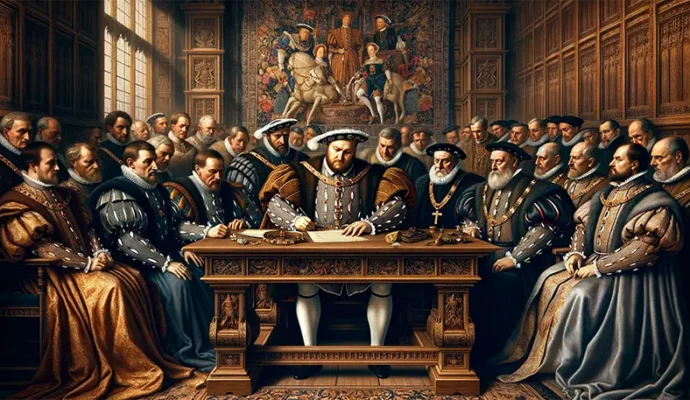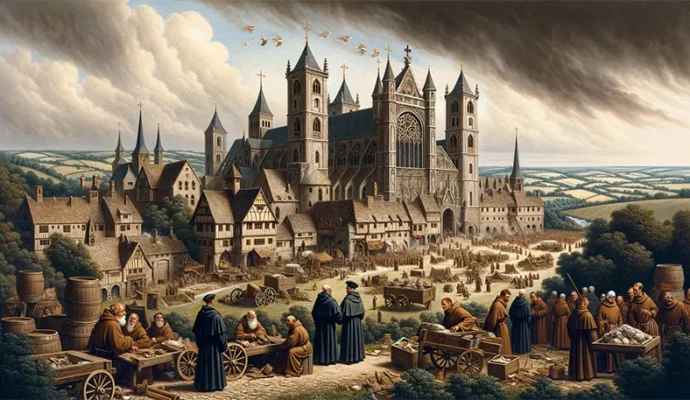
TL:DR King Henry VIII founded the Anglican Church because he wanted to divorce his first wife and the Pope refused.
Once Upon a Tudor Time: Henry VIII’s Dilemma
Tudor England was a land of grand castles, lavish feasts, and intricate politics. At the heart of it all was King Henry VIII, a man of great power and strong desires. He had a problem. He wanted to marry but there was the slight snag that he already had one, He’s not quite there yet to off her head, she was royal after all, so he wants to annul his marriage to Catherine of Aragon, but the Pope isn’t exactly on board with his plan.
A Divine Decision: The Birth of the Anglican Church

So, what’s a king to do? If you’re Henry VIII, you take matters into your own hands. In 1534, he passed the Act of Supremacy, declaring himself the Supreme Head of the Church of England. This wasn’t a whim, but a calculated move to assert his authority over the Church. And just like that, the Anglican Church was born!
A Reformation Revolution: The English Church’s New Identity
With the formation of the Anglican Church, a wave of religious and political changes swept across England. This period, known as the English Reformation, saw the dissolution of monasteries and the adoption of Protestant ideologies. However, some Catholic traditions were kept, creating a unique blend of faith and worship. But what happened to all the wealth these monasteries held?
The Fate of Monastery Wealth: A Royal Redistribution

When Henry VIII ordered the dissolution of monasteries, he also seized their lands and wealth. This wealth was redistributed in several ways. Some of it was used to fund royal projects and fill the royal coffers. A significant portion was also granted to loyal nobles and courtiers, helping to create a new landed gentry. Lastly, some of the wealth was used to establish new institutions, such as schools and hospitals.
The Tudor Tug-of-War: Anglican vs. Catholic
The religious landscape of Tudor England was far from stable. After Henry VIII’s death, his son Edward VI furthered the Protestant cause. But when Mary I, a devout Catholic, ascended the throne, she tried to restore Catholicism, earning her the nickname “Bloody Mary.” It was under Elizabeth I that the Anglican Church found a stable middle ground, blending elements of both faiths.
The Anglican-Catholic Divide: Key Differences
The Anglican Church differed from the Catholic Church in several ways:
Authority: In the Anglican Church, the monarch is the Supreme Head, replacing the Pope’s authority in England.
Language: The Anglican Church introduced services in English, making worship more accessible to the common people, while the Catholic Church retained Latin.
Marriage of Clergy: Unlike the Catholic Church, the Anglican Church allowed its priests to marry.
Communion: The Anglican Church rejected the Catholic doctrine of transubstantiation, instead adopting a more symbolic view of Communion.
The Anglican Church Today: A Royal Legacy
Fast forward to today, and the Anglican Church remains a significant part of English culture and heritage. With over 85 million members worldwide, it stands as a testament to the enduring impact of King Henry VIII’s quest for a divorce. The Church continues to evolve, embracing modernity while honouring its rich Tudor roots.
Fun Facts: The Anglican Church and Its Tudor Ties
The Anglican Church is part of the larger Anglican Communion, which includes churches in over 165 countries.
The Archbishop of Canterbury, the Church’s spiritual leader, still plays a role in royal events, like coronations and weddings.
The Book of Common Prayer, introduced in 1549, is one of the Anglican Church’s most enduring contributions to English literature and language.
More Information:
- The Tudors – KS3 History – BBC Bitesize
- Reformation 1517-2017 at the British Library – European studies blog
- The Church of England: History of the Church of England | The Church of England
- The Six Wives of Henry VIII” by Alison Weir – A detailed account of the women behind the man who changed the course of religious history.
- The Reformation: A History” by Diarmaid MacCulloch – An expansive look at the religious upheaval that reshaped Europe.
- “Elizabeth I” by Anne Somerset – A biography of the queen who navigated the church through its formative years.
